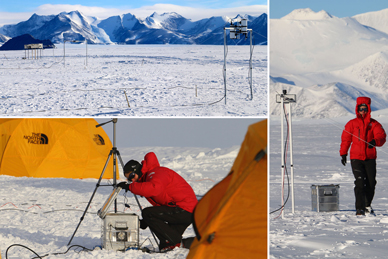- After four weeks of work in the Antarctica, Dr Raúl Cordero and Dr Alessandro Damiani, both researchers at the Department of Physics of Universidad de Santiago de Chile, were able to confirm that the extension of the hole in the ozone layer over the Antarctica reached more than 10 million km2 in December 2015, i.e. more than twice the average of that period in the past three decades.
The measurements were carried out during a campaign in the Antarctic Circle in the context of the Antarctic Scientific Expedition of the Chilean Antarctic Institute (Inach, in Spanish). Dr Raúl Cordero and Dr Alessandro Damiani, both professors at Universidad de Santiago de Chile, were part of the expedition.
The ozone measurement campaign at the Antarctica started on November 15th and it continued until mid-December. Four researchers at Universidad de Santiago travelled to the heart of the White Continent, where about 600 kg of the best radiometric equipment available were sent.
The expedition was supported by Inach, what allowed the researchers to work at “Unión Glacier” Joint Polar Research Station located at 79 degrees South latitude, at about 1000 from the South Pole.
Constant monitoring
In spite of the negative results of this year, Dr Cordero expects that a process to recover the ozone layer starts in the short term, as a result of the actions taken worldwide to reduce the emissions of polluting gases. However, the information gathered highlights the need of adopting mitigation policies and conducting a constant monitoring of the area.
According to Dr Cordero, “the ozone layer depletion is mainly caused by the presence of ‘ozone destroying” chemicals in the polar stratosphere. These substances are generated by the industrial activity in mid-latitudes.”
Although these substances are everywhere in the planet, high latitudes are the most impacted areas by the layer depletion or destruction, particularly the Antarctica. During the southern spring, this area is affected by a massive destruction of the stratospheric ozone as a result of the particular weather conditions there.
According to the researcher, the ozone depletion process between September and December is favored by the low temperatures in the Antarctic stratosphere and by the Antarctic polar vortex that prevents the ozone from other latitudes from closing the hole.
“When temperatures increase at the end of spring, the ozone massive depletion stops and the weakening of the polar vortex allows the ozone from other latitudes to close the hole. The bad records this year are probably the result of unusually low stratospheric temperatures during last spring,” Dr Cordero said.
Recovery of the ozone layer
In spite of the negative results of this year, Dr Cordero expects that a process to recover the ozone layer continues until the middle of this century due to the actions taken worldwide to reduce the emissions of polluting gases. However, the information gathered highlights the need of adopting mitigation policies and conducting a constant monitoring of the area.
It is also worth to mention that this study included comparisons with databases of other months. According to this, the hole in the ozone layer reached 28 million km2 in October, the fourth highest record since the satellite data is available.
Dr Cordero also highlights the relation between ozone depletion and climate change. “The changes in the hole in the ozone layer could affect the energy balance of the Antarctica. Ozone depletion or exhaustion has affected the temperature of the stratosphere and it correlates with wind and surface temperature variations detected in the Antarctica in the past decades. Therefore, a better understanding of the relation between climate change and the hole in the ozone layer is required. This is the ultimate goal of our work,” he concluded.
Translated by Marcela Contreras



